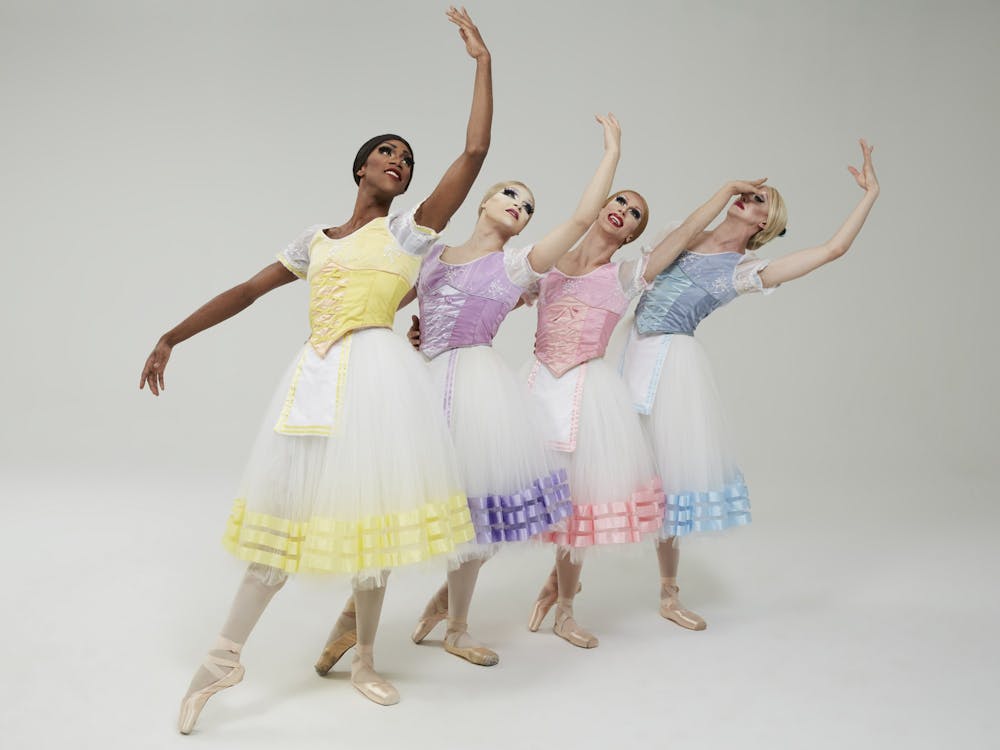In recent years, the world of ballet has been increasingly scrutinized for its inaccessibility and lack of diversity, but Les Ballets Trockadero de Monte Carlo has been keeping the art on its toes since the 1970s.
Colloquially known as the Trocks, the all-male, comic drag ballet troupe will perform Saturday, Feb. 22 at the Carolina Theatre in a co-presentation with Duke Performances. The Trocks officially began in 1974 as an outgrowth of Charles Ludlam’s Theater of the Ridiculous in Greenwich Village, where the Stonewall riots took place. In the nearly half-century since, attitudes toward drag in the mainstream shifted greatly, but the troupe’s commitment to inclusion and joy have remained consistent.
The troupe’s comedic performances include parodies of classical ballets such as “Don Quixote” and “The Nutcracker.” In traditional performances of these ballets, principal female roles are typically performed en pointe, a technique in which a dancers’ entire body weight rests upon the tips of the toes. Pointe training, even now, is often reserved for female dancers, but the Trocks are at the forefront of a growing movement of blurring the form’s gender expectations.
“I think times have changed. It seems to be more common now that guys are trying [pointe], because it’s really good for your ballet training. It really helps you find your balance and your center,” said Duane Gosa, a seven-year veteran dancer in the company. “So I think a lot of schools and male dancers have decided to give it a shot.”
Gosa first encountered pointe — and the Trocks — while studying dance at the University of Akron. Joining the dance world relatively “late” at age 16, the university’s dance program was Gosa’s first exposure to what a career in the field could look like for him.
“I kind of got a better perspective of … the types of roles that a male dancer would do, and [they weren’t] as interesting to me as female roles,” Gosa said. “I remember putting on a pointe shoe and wanting to see what that felt like.”
After he successfully convinced the program to allow him into pointe classes, Gosa’s faculty mentors pushed him to look into the Trocks. But burnout eventually turned him away from ballet near the end of his college career, and shortly after graduation, he found himself in a contemporary-modern dance company.
“I was like, ‘You know what, I am much stronger at other things, and I think I’ll be happier if I don’t torture myself with ballet.’ And then I was kind of in a rut with what I was doing and where I was, and I kind of felt stuck,” Gosa said. “So then I looked online and [the Trocks] had an audition, and I thought, ‘Let me just give it a shot — why not?’”
Joining the Trocks meant performing in drag, something Gosa had limited experience with prior to auditioning for the company.
“I think every gay man thinks about what it’s like to have a pair of heels and a wig on, so of course I was intrigued by it,” Gosa said. “It really helps when you’re with a group of people. When everyone’s doing the same thing, you feel a little more supported and safe.”
After one last-minute Halloween costume provided Gosa his first experience in drag over a decade ago, he initially decided not to pursue it further.
“I remember putting on the wig and looking at myself in the mirror and I was like, ‘I can’t go out looking like this.’” Gosa said. “I was freaked out about it. Because, you know, it brings a lot of attention. And especially 10-plus years ago, [drag] wasn’t as mainstream as it is now.”
These days, widely-beloved shows like “RuPaul’s Drag Race” and “Pose” have brought drag culture and history onto a global stage. The Trocks, whose legitimacy in the dance world was once subject to question, are now participants in RuPaul’s DragCon and are consistently afforded gravitas as trained dancers and culturally-significant artists.
“I do think we’re a very distinct part of American culture and American dance, so it really does feel like we’re kind of ambassadors of culture,” Gosa said. “There are [still] some people who oppose the idea, but they’re just on the wrong side of history, you know? I just feel like people who speak that way are looking for attention. I think, for the most part, everyone is delighted and amused by [us].”
Though the company’s dancers are highly-trained and increasingly bringing in extensive pointe backgrounds, Gosa believes that their continued raison d’être is bringing “joy and light-heartedness” to ballet, encouraging audiences and dancers alike to eschew pretension.
”I hope people get the idea of — just joy. Joie de vivre. There is joy in everything, and I think our purpose in life is to appreciate that,” Gosa said. “Especially with ballet — the ballet world can [feel] so self-serious and esoteric, but it’s really not. Ballets are storybooks, they’re fantasies — and we’ve all learned fairytales. Ballet is really for everyone to enjoy.”
Get The Chronicle straight to your inbox
Signup for our weekly newsletter. Cancel at any time.

